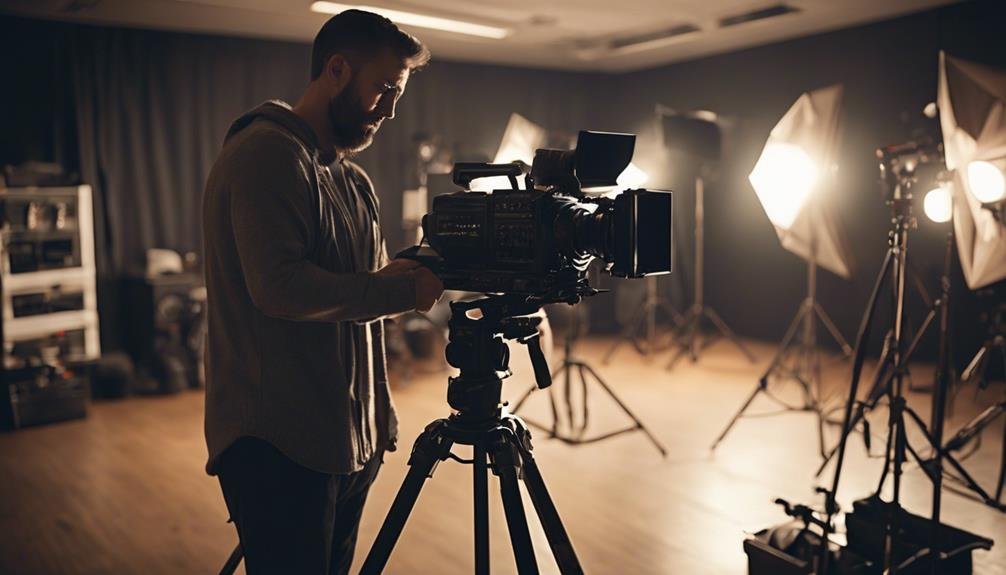How to Start a Professional Photography Studio
When starting a professional photography studio, think of it as laying the foundation for a sturdy building. As you navigate the intricacies of studio setup and equipment selection, a crucial aspect that often gets overlooked is the importance of honing your unique photography style.
This defining element sets you apart in a crowded market and keeps clients coming back for more. But there's more to consider beyond just your style.
Want to know how to truly make your mark in the competitive world of professional photography?
Key Takeaways
- Plan studio layout efficiently, optimize space use.
- Invest in quality lighting equipment for stunning photos.
- Align pricing with expertise, offer diverse packages.
- Personalize services, communicate with clients for success.
Setting Up Your Studio Space
When establishing your photography studio, deck out your studio space with essential equipment and create a versatile setup to maximize creativity and efficiency. Begin by carefully planning your studio layout to ensure optimal use of space. Consider creating different zones for shooting, editing, and client meetings. This will help you stay organized and efficient during your workday.
Next, focus on equipment placement to streamline your workflow. Position your photography backdrop in a dedicated area with ample natural light or invest in quality studio lighting for controlled shoots. Keep frequently used equipment like cameras, lenses, and tripods within easy reach to avoid disruptions during sessions. Utilize shelving or storage units to keep your space tidy and clutter-free.
Choosing the Right Equipment
When starting your photography studio, selecting the essential gear, exploring different lighting equipment options, and considering necessary camera accessories are crucial steps.
Make sure to equip yourself with the right tools to capture stunning photos, manipulate light effectively, and enhance the capabilities of your camera.
Understanding the significance of each piece of equipment will help you create a well-rounded studio setup that meets your specific photography needs.
Essential Gear Selection
To set up a successful photography studio, carefully selecting the essential gear is crucial for ensuring the quality of your work and the satisfaction of your clients. When choosing your equipment, consider investing in high-quality cameras, lenses, tripods, and memory cards.
Proper gear maintenance is key to prolonging the lifespan of your equipment, so make sure to clean your gear regularly and store it in a safe place. Additionally, always have backup solutions in place, such as extra batteries, memory cards, and even a backup camera, to prevent any disruptions during a photoshoot.
Lighting Equipment Options
Selecting the right lighting equipment is essential for creating stunning photographs and setting the mood for your shoots. When comparing lighting techniques, consider using softboxes for diffused light or umbrellas for a broader spread. LED panels offer versatility and consistency, while strobe lights provide powerful bursts of light for dynamic shots.
For budget-friendly options, fluorescent lights are cost-effective and work well for studio setups. Consider investing in a reflector to bounce and redirect light creatively. Recommendations for beginners include starting with a basic lighting kit that includes a key light, fill light, and backlight.
Camera Accessories Needed
To complement your lighting setup, selecting the right camera accessories is crucial for achieving professional results in your photography studio. Camera maintenance is key to ensuring your equipment performs optimally. Here are some camera maintenance tips:
Camera Maintenance Tips:
| Camera Accessories | Maintenance Tips | Accessory Organization |
|---|---|---|
| Lenses | Clean lenses with a microfiber cloth | Store lenses in a protective case |
| Tripod | Check for loose screws regularly | Keep tripod parts together in a designated bag |
| Camera Bag | Clean bag interior with a vacuum | Use dividers to organize cameras and accessories |
For budget-friendly options, consider DIY solutions like creating your own lens cleaning solution or making a camera strap from a sturdy belt. Proper maintenance and organization can prolong the life of your camera accessories.
Developing Your Photography Style
Crafting a distinct photography style that resonates with your audience requires experimentation, authenticity, and a keen eye for detail. To develop your unique style, consider the following:
- Creative Vision: Define what message or emotions you want your photos to convey. Experiment with different composition techniques such as rule of thirds, leading lines, or framing to enhance the visual impact of your images.
- Color Grading: Mastering color grading techniques can significantly influence the mood and atmosphere of your photos. Understand how different color palettes evoke specific emotions and learn to use color grading tools effectively during post-processing.
- Post Processing Skills: Enhance your photos through post-processing to achieve a consistent look and feel across your portfolio. Develop your skills in editing software to refine lighting, contrast, and sharpness, ensuring your final images align with your creative vision.
Building a Portfolio
When building a portfolio for your photography studio, focus on showcasing diverse styles to attract a wider range of clients.
Highlight your technical skills to demonstrate your expertise in capturing high-quality images.
Additionally, make sure to showcase your editing prowess to show potential clients the full extent of your capabilities.
Showcase Diverse Styles
Diversifying your portfolio with a range of styles is crucial for showcasing your photography studio's capabilities and attracting a broad clientele base. To achieve this, consider the following:
- Creative Compositions: Incorporate unique angles, lighting techniques, and perspectives to add depth and interest to your images.
- Artistic Approach: Infuse your photos with emotion, storytelling elements, and artistic flair to captivate viewers and leave a lasting impression.
- Experimenting with Techniques: Don't be afraid to push boundaries, try new editing styles, and play with different photography methods to develop a signature look that sets your studio apart.
Highlight Technical Skills
Highlight your technical expertise by curating a portfolio that showcases your proficiency in various photography techniques and equipment. Your portfolio should demonstrate a strong grasp of composition skills, illustrating your ability to frame shots effectively and create visually appealing images.
Include a variety of subjects and settings to showcase your versatility. Additionally, highlight your post-production techniques by including edited photos that showcase your ability to enhance and refine images. Showcasing a range of editing styles will emphasize your skills in this area.
Demonstrate Editing Expertise
To showcase your editing expertise effectively in your photography portfolio, incorporate a diverse range of post-production techniques that highlight your ability to enhance and refine images creatively. When building your portfolio, focus on the following key elements:
- Color Correction: Display your skills in adjusting tones, hues, and saturation levels to create visually appealing images with accurate colors.
- Retouching Techniques: Demonstrate your proficiency in retouching portraits by smoothing skin imperfections, removing blemishes, and enhancing facial features while maintaining a natural look.
- Creative Editing: Showcase your artistic vision by experimenting with different editing styles, such as black and white conversions, vintage effects, or composite imagery, to illustrate your versatility and creativity.
Establishing Your Pricing Structure
When setting up your photography studio, it's crucial to carefully establish a pricing structure that reflects the value of your services and satisfies both your financial goals and your clients' expectations. Begin by conducting a competitive analysis to understand the pricing models of other photographers in your area. This will help you determine a pricing strategy that's competitive yet sustainable for your business.
Next, focus on your value proposition. Highlight what makes your photography unique and why clients should choose you over others. Your pricing should align with the quality of your work, your expertise, and the overall experience you provide to your clients.
Consider offering different packages or a la carte options to cater to a variety of budgets and needs. Be transparent about what each package includes to avoid confusion.
Marketing and Promoting Your Studio
Get ready to elevate your photography studio by implementing effective marketing strategies to attract and engage potential clients. To successfully market and promote your studio, consider the following:
- Online Advertising: Utilize online platforms such as Google Ads or social media advertising to reach a broader audience. Target your ads based on demographics, interests, and online behavior to maximize their impact.
- Social Media Outreach: Leverage the power of social media platforms like Instagram, Facebook, and Pinterest to showcase your work, engage with followers, and attract new clients. Share behind-the-scenes glimpses, client testimonials, and exclusive promotions to keep your audience interested and connected.
- Networking Events: Attend local networking events, trade shows, and community gatherings to meet potential clients and collaborators. Building relationships in person can lead to valuable word-of-mouth referrals and partnerships that can help grow your photography business.
Managing Client Relationships
How can you effectively nurture and maintain strong client relationships in your photography studio? Client communication and feedback are key aspects to focus on. Regularly communicate with your clients to understand their needs and expectations. Listen actively to their feedback, whether positive or negative, to improve your services continuously. This will not only show your clients that you value their opinion but also help in building trust and loyalty.
To ensure customer satisfaction and retention, consider the following strategies:
| Strategy | Description | Benefits |
|---|---|---|
| Personalized Service | Tailor your services to meet each client's unique preferences. | Enhances client experience and satisfaction. |
| Timely Responses | Respond promptly to client inquiries and concerns. | Shows professionalism and care for clients. |
| Client Appreciation | Show gratitude through small gestures like thank you notes. | Builds a sense of value and loyalty. |
| Quality Deliverables | Consistently provide high-quality photos and products. | Increases client satisfaction and referrals. |
| Exclusive Offers | Offer special deals or discounts to returning clients. | Encourages repeat business and client loyalty. |
Expanding Your Services
To elevate your photography studio's reach and impact, consider broadening your range of services to cater to a wider audience and enhance your business's growth potential. Here are three ways to expand your services effectively:
- Diversify Your Service Packages: Offer a variety of photography packages to appeal to different client needs and budgets. Create packages for events, portraits, commercial shoots, and more. By providing a range of options, you can attract a broader clientele and increase your revenue streams.
- Enhance Client Communication: Improve your client communication by being responsive, attentive, and professional. Keep clients informed about your services, pricing, and any promotions you may have. Clear and prompt communication builds trust and loyalty, leading to repeat business and referrals.
- Add Specialized Services: Consider adding specialized services such as photo editing, retouching, or photo restoration. These additional services can set you apart from competitors and attract clients looking for comprehensive photography solutions. By offering unique and valuable services, you can position your studio as a one-stop-shop for all photography needs.
Conclusion
As you embark on your journey to start a professional photography studio, remember that every picture you take is like a brushstroke on the canvas of your career. Your studio space is your blank canvas, waiting for you to fill it with your creativity and passion.
With the right equipment, style, portfolio, pricing structure, marketing strategies, and client relationships, you can paint a masterpiece that will leave a lasting impression on everyone who walks through your studio doors.







